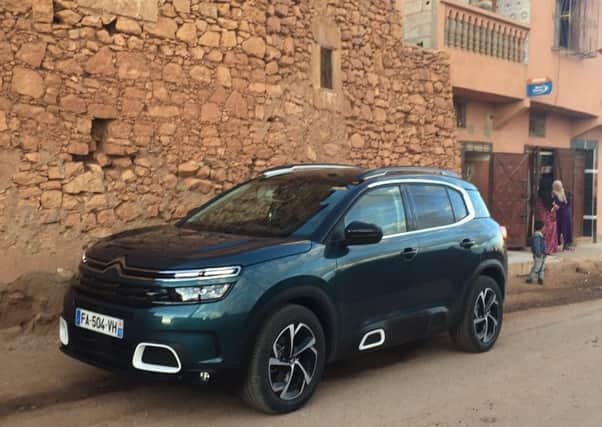Review: Citroën C5 Aircross'


France has history in North Africa. Morocco was controlled by France from 1912 to 1955, adopting its language and customs. Peugeot vehicles and cycles were imported across large parts of the continent.
In Marrakech, another French company, Citroën, was splashing out euros on the promotion for its latest car, the C5 Aircross. Several hundred journalists from around the world have been assessing this “comfort class SUV”. The location was the Fairmont Royal Palm, a 570-acre greening of the desert with a 2,000 square metre outdoor swimming pool and a 3,500 sq m spa. A pro-am golf tournament was taking place. Robed figures toted the kit from limo to hotel. The media felt quite at home.
Advertisement
Hide AdAdvertisement
Hide AdWe were soon driving away from the modern face of Morocco, into the valleys and hills, through communities where the donkeys and camels and Berber shepherds contrast with 200mph trains and black MPVs carrying tourists to activity holidays on quad bikes and hang gliders.
The route south of Marrakech to Asni traversed slopes where heavy rain had smothered the road with mud, leaving red ruts and water sluices and loose gravel. Even where the country roads were smoothly surfaced, their width has been eroded over the years to accept one vehicle, with broken edges for the under-dog – often the Citroën.
It is the sort of terrain which makes the fast Al Boraq train appealing for those A to B to C travellers. For the C5, a cute, tug-shaped five-door, five-seat family car, the demanding roads were a good test of its new suspension, already satisfactorily proved on the smaller C4 Cactus. The damper spring units are fitted with compression and rebound stops which allow a softer flying carpet progress over dips and bumps. At the end of the suspension travel they slow the action, absorbing the energy and avoiding rebound. These progressive hydraulic cushions are more fully explained in Citroën literature and on its website.
Maybe Citroën should reprise the design ambition for the 1948 2CV to be able to carry a basket of eggs across a ploughed field without cracking a shell? It resuscitates Citroën’s reputation for smart, comfortable suspension, inspired by the Traction Avant of the 1930s and then in the hydropneumatic springing introduced on the influential 1955 DS. PHC is its simplified successor.
While it does make the car pleasantly comfortable and supple, there are other factors to consider. All three rear seats are of identical size so no-one is squished in the middle. They can be moved to and fro, reclined or folded flat without fuss. There is a large boot too.
The nine-inch ground clearance, buffered body and roof bars hint at its SUV ambitions.
Aircross prices begin at £23,225 for the three-cylinder 1.2 litre 130hp petrol engine in Feel specification and £24,725 for the 1.5 litre 130hp diesel (£26,325 as an eight speed automatic). The higher trim levels are Flair (from £25,325) and Flair Plus (from £27, 725). These two trims are offered with a 1.6 litre 180hp petrol and 2-litre 180hp diesel engine with automatic gears. Deliveries start in February. There will be a plug-in petrol/electric hybrid and fully electric models in 2020.
Tested in Morocco were both 180hp models. The diesel, weighing an additional 110kg, had a more settled ride on troubled surfaces. The torquier diesel is rated at 60.1mpg and 124g on 19 inch wheels. The trip computer suggested 35.7mpg on our long test drive, mostly at well under 60mph. The petrol model, rated at 49.6mpg and 129g, recorded 32mpg on a similar route. Let’s hope daily life will see a rise in the economy. I can’t say I preferred either car to the other and so for low mileage life as a cash buyer I would save money and get the petrol engine.
Advertisement
Hide AdAdvertisement
Hide AdDoes the C5 Aircross meet its “inspired by you” and “comfort class SUV” slogans? Not having driven in Morocco for six years (a Range Rover) it’s hard to assess how, say, a rival Peugeot 3008 would manage the terrain. Judged on its own, the Citroën gave a calm and serene experience on most of the roads. It cruised quietly. The foam-faced seats are comfortable. The car is strewn with plenty of places for “stuff” – par for the sector really. Some harder cabin surfaces and edges illustrate differences from the Peugeot. They are not of huge significance.
Verdict: A serious contender. The latest in a line of usually significant and sometimes brilliant Citroën’s as the classic marque enters its centenary year.